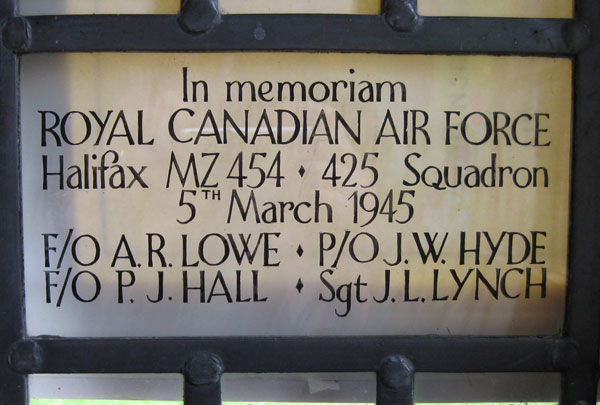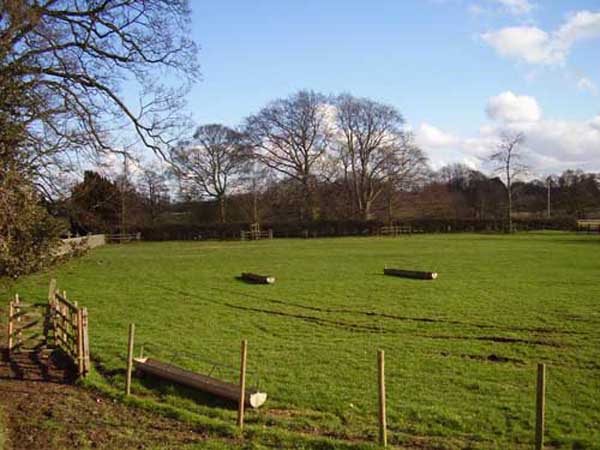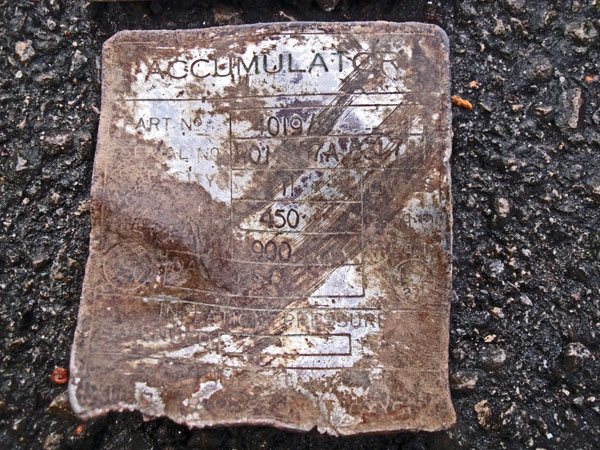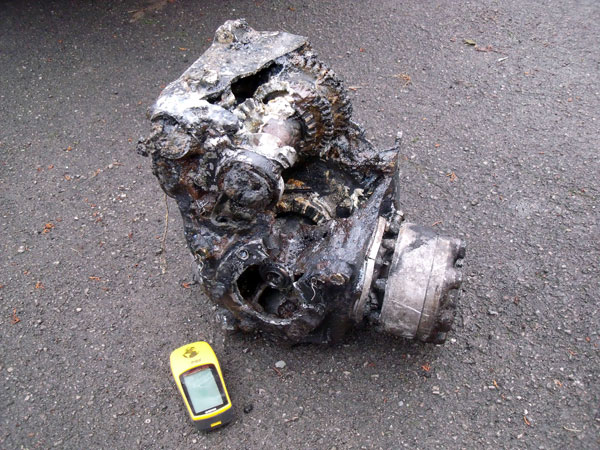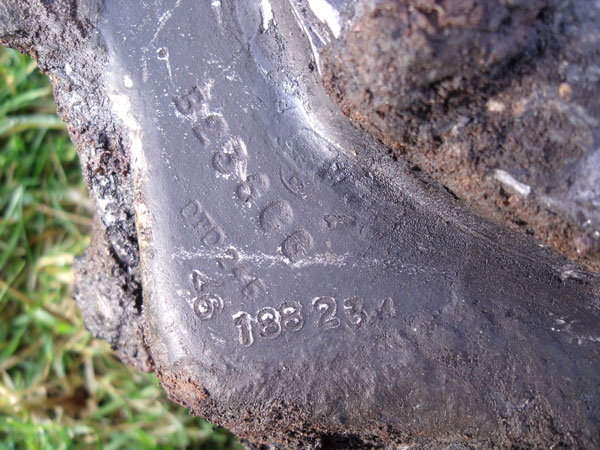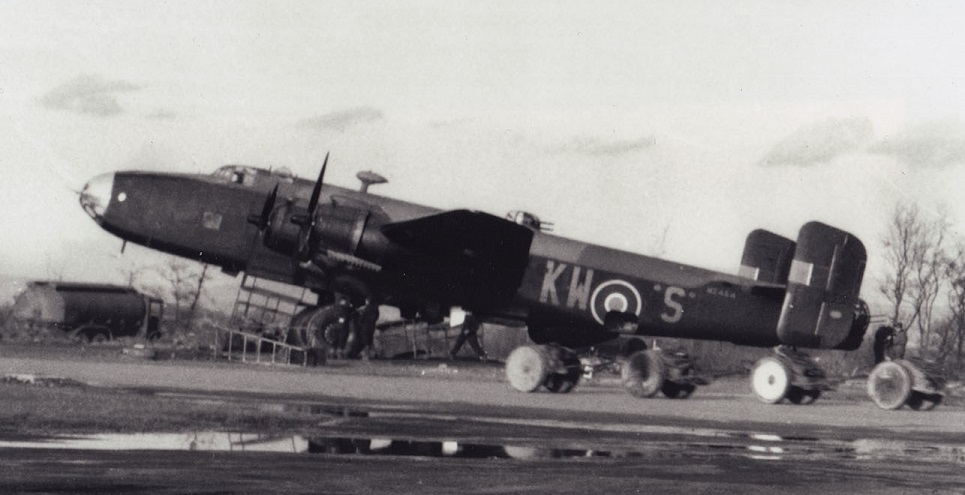
Halifax MZ454.
In the late afternoon of 5th March 1945 severe weather conditions were effecting flying over Yorkshire and these conditions were not forcast prior to a number of aircraft taking off for operational sorties to bomb Chemnitz and many aircraft iced up just after leaving their home airfields. Halifax MZ454 took from Tholthorpe at 16.40hrs and twenty minutes later it was returning to base suffering from these icing conditions when it crashed close to Little Ouseburn church. A crash investigation found in the National Archives on all the accidents on this night refers in brief to the accident at Little Ouseburn, it states that "this aircraft had crashed in a shallow dive as it had cut sideways through some trees. Here also was a deep crater where the bomb load had exploded. Only one whole engine was found, the parts of the others were located. There was no sign of fire on this engine at all but every sign of sufficient lubrication." Four of the crew were killed but three survived after baling out at low level just before the aircraft struck the trees. The exploding bomb load caused the severe damage to the nearby church but it was later repaired and a memorial stained glass window in the church porch was installed in 1995.
Pilot - F/O Arthur Robert Lowe RCAF (J/29556), aged 23, late of Red Bank, New Jersey, USA. Initially buried Harrogate Stonefall Cemetery, Yorkshire. Buried Red Bank Fairview Cemetery, New Jersey, USA.
Flight Engineer - Sgt James Laurids Lynch RCAF (R/201189), aged 20, of Windsor, Ontario, Canada. Buried Harrogate Stonefall Cemetery, Yorkshire (G/H/16).
Air Gunner - F/O Paul John Hall RCAF (J/43949), aged 20, of St.George's, Newfoundland. Buried Harrogate Stonefall Cemetery, Yorkshire (G/H/10).
Air Gunner - P/O John William Hyde RCAF (J/95349), aged 35, of Vancouver, British Columbia, Canada. Buried Harrogate Stonefall Cemetery, Yorkshire (G/H/9).
Navigator - F/O E S (Earl Stuart?) Brabbins RCAF (J/40690). Slightly injured.
Bomb Aimer - F/O J F Brownell RCAF (J/40341), of Windsor, Ontario, Canada. Slightly injured.
Wireless Operator / Air Gunner - F/Sgt K J S McCuaig RCAF (R/204103), of Kirkland Lake, Ontario, Canada. Slightly injured.
The crew on board Halifax MZ454 when it crashed near Little Ouseburn.
Arthur Lowe was born on 19th November 1921 in Toronto, Ontario, Canada and was the son of Arthur Robert Acton Lowe and Charlotte Mary (nee Argles) Lowe. He lived in Toronto until 1932. In 1932 he was adopted by Mr and Mrs John Wright Brown and went to live at Red Bank, New Jersey, USA. His birth-father would serve in WW1 in the armed forces and also in the RCAF during WW2 and may ahve been a serving officer in the 1930s in Canada. Arthur was attending Yale University when he enlisted for RCAF service in Ottawa on 20th July 1942 and trained as a pilot, receiving his pilots' flying badge and also a commission on 20th August 1943. Following his death he was initially buried in Harrogate Stonefall Cemetery but rarely for RCAF service burials in the UK, he was later exhumed and returned home to the USA and he now lies in Fairview Cemetery, Red Bank, New Jersey. Fairview Cemetery is where some of the Titanic victims were also buried.
James Lynch was born on 27th April 1924 in Windsor, Ontario, Canada and was the son of James Therodore and Anna Laurine (nee Hyttenrauch) Lynch. He was working as an apprentice for Ford Motors as a tool and die maker when he enlisted for RCAF service on 8th December 1942 in Windsor. After initially starting pilot training in Canada he transferred to flight engineer training and was awarded his Flight Engineer's badge on 6th May 1944. On arrival in the UK in June 1944 he would spend time at 1659 HCU, 1666 HCU and 1664 HCU before eventual posting to 425 Squadron on 9th January 1945. I have yet to find out why he served at three heavy conversion units.
Paul Hall was born on 5th December 1924 in St.George's, Newfoundland was the son of John and Kate (nee Gillis) Hall. His father died in 1935 and. In 1942 and early 1943 Paul worked as a contracted tractor operator for the U.S.Army at Stephenville; he was almost certainly a paid civilian employed to build the Ernest Harmon Air Force Base at Stephenville, Newfoundland until May 1943 when presumably his work was complete. He then enlisted for RCAF service on 22nd September 1943 in St.Johns, Newfoundland. After basic training he was awarded his Air Gunner's badge and was also appointed to a commission on 7th April 1944. He was posted overseas the following month and on arrival in the UK trained at 82 OTU, 1666 HCU and 1664 HCU before posting to 425 Squadron on 9th January 1945. Two of his brothers served in the Canadian Army during WW2.
John Hyde was born on 27th December 1909 in Erickson, British Columbia, Canada and was the son of John Henry and Ethel May (nee Lindsay) Hyde. The family moved to Peachland when he was young and then to Vancouver in 1924. After finishing at high school he had undertaken various jobs in the Vancouver area. He married Gertrude Elizabeth Day in 1935 and they had two sons. He was working as a lumber inspector when he enlisted for RCAF service on 24th September 1943 in Vancouver and after basic training in Canada he was awarded his Air Gunner's badge on 21st April 1944. He was then posted to the UK and trained at 82 OTU, 1666 HCU, 1664 HCU before posting to 425 Squadron on 9th January 1945. He received a commission after his death back dated to 4th March 1945. His brother Wilton Alexander Hyde also served in the RCAF.
The memorial window in the church porch at Little Ouseburn.
In November 2010 Ken Reast, Dick Barton and Albert Pritchard sought permission to enter the field from the landowners of the field shown above. The aircraft is known locally to have crashed in the small field between Moat Hall and Little Ouseburn church but little appears recorded locally with regard the events leading up to the aircraft exploding in this field. Later that month I was invited by them to come on with them on their visit to the land. A number of small pieces of the aircraft were located and after a series of telephone calls to other residents a large piece of one of the aircraft's engines was found in woodland through which the aircraft had flown through just prior to crashing. While we took this engine part away to clean up and photograph it was returned to the landowner and is preserved locally. I would like to thank (the now late) Hilary and Anne Gregory of Moat Hall for their assistance and patience and for allowing our visit. Hilary was unwell when we visited but was very helpful in assisting us, sadly he died shortly after our visit.
Two plates from aircraft ancilliaries found at the crash site.
The piece of engine we found, photographed after gentle cleaning and with the hand-held Garmin GPS for scale.
Markings found on the engine part.

